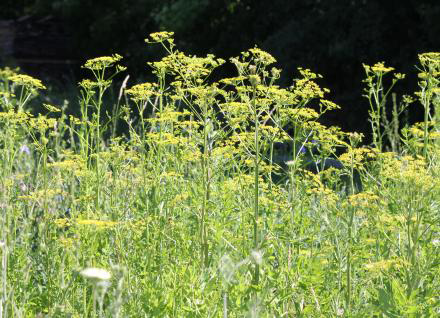Removing wild parsnip to prevent further spread
[vc_row][vc_column][vc_column_text]

It’s spring and it’s glorious. The chipping sparrows, white throated sparrows, robins and bluebirds have returned to the yard to feed on seed in the feeders joined by red-bellied, downy, hairy and pileated woodpeckers on the suet cakes. A phoebe has built a nest on my front porch. I’m looking forward to phoebe babies. The grass seed that was spread to repair damage done by the voles is fair game for the birds, squirrels and chipmunks. The lawn and field are Fenway Park green now. All is well but, but, but wait… WHAT is that low-spreading, fern-like plant protruding from the earth on my Fenway Park? Omigosh, it’s a young wild parsnip plant!
Grab the shovel, drag it out by its feet, throw it into a black plastic trash bag (better than it deserves), place it in the sun and let it rot!
Wild parsnip has spread widely in Charlotte along roadsides, fields and adjacent to ponds and streams where mowers never reach and where the fields and roadsides were mowed after wild parsnip seed heads were formed. I know how this can happen. About 10 years ago my field was “planted” with wild parsnip seeded by a mower that had previously mowed a field supporting these plants. For the past 4-5 years I have been somewhat successful in removing wild parsnip by mowing when the plants have blossomed and before the plants have gone to seed. For persistent plants, I put on gloves and a long- sleeved shirt to prevent contact with the plant’s sap that causes a nasty skin burn when exposed to sunlight. Wild parsnip has been frighteningly successful in Vermont. In mid-summer, thousands of these noxious plants inhabit the roadside of I-89, extending their inexorable grip deep into the adjacent fields.
Best that we take steps now to prevent further spread of wild parsnip. Wildlife that forage in fields and along waterways and ponds will move on as these incredibly successful plants form dense barriers. And as for Vermont’s livestock, the quality of hay harvested from fields with wild parsnip will not be suitable as feed for our domesticated beasts.
I don’t have the answer to this problem in Charlotte, but well-timed mowing of fields and roadsides over several years may at least slow the spread. I’m open to other suggestions. How about a volunteer wild parsnip removal team? Maybe a wild parsnip Green-Up Day in the rain or at dusk? In the meantime, I need to get back to clearing my field.[/vc_column_text][/vc_column][/vc_row]

